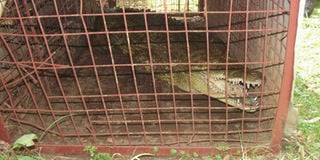Crocodiles make Alokolum seminary a tourist destination

One of the crocodiles in the cage at Uganda Martyrs National Major Seminary. PHOTO BY ALICE ADIKIN
Sting and snoozi are names of the two male crocodiles that were brought by the catholic Brother Joachim Parr in 1971. The two predators were brought from the US by the late Parr who was a zoologist and Biology teacher for then high school students for study purposes before the institution turned into a seminary in 1973.
Despite dying in 1985, Parr’s vision for the crocodiles has expanded from serving education purposes to being tourist attractions in the area.
Located in Omoro District in northern Uganda, Uganda Martyrs National Major Seminary is 7kms away from Gulu Town. The crocodiles live in an area the institution named Br Joachim Parr Zoological Garden in honour of the late Parr.
There are two students appointed to take care of the crocodiles during school days and designated employees during holidays.
“When I was posted here in 2007 as a Rector, the two crocodiles were living behind our library. But for respect of the seminary, we built a home for them near the gate which is more accessible to the tourists without interfering with activities of the institution,” Dr Cosmas Alule explains.
Apart from crocodiles, tourists, mostly foreigners, are attracted by different tree species such as eucalyptus trees at the entrance to the seminary, queen tree, umbrella tree, oak tree and other types of British and Latin medicinal trees and rose flowers, among others. The serene environment, which is drought-resistant also enhances the seminary’s beauty.
“Whenever those tourists are here they say they feel at home because of the cool nature of this place,” he says.
Another centre of attraction is the Uganda martyrs monument in the compound, designed in form of tongues of fire to explain the way the martyrs were executed by fire. Beside the monument are Daudi Okello and Jilido Irwa, the Acholi catechists who were added in as martyrs in 2007.
“Students get excited by this monument’s design and wonder how they placed a tongue of fire on every martyr’s head,” Dr Alule says.
He adds that the reason they constructed the monument at the compound is because the seminary is being adopted by the Uganda martyrs as their patron saint.
Dr Alule says there is no fee required for one to enter the seminary and enjoy all these tourist attractions but some schools and individuals sometimes make donations after touring. Part of that money is used to buy meat for the crocodiles.
Habitation
Like crocodiles that live in water bodies, the seminary dug two separate water ponds, cleaned on weekly basis, separated by a wire mesh fence. There is a stand-by tap which feeds the pond with water. The crocodiles used to share the pond until they grew up and started fighting for dominance.
Feeding
Dr Alule says the crocodiles are fed on lean fresh meat or fresh fish. Once the meat has stayed for some hours, they cannot consume it. It is their nature.
He says formerly each crocodile used to consume two kilogrammes of meat/fish but as they grew bigger they started eating three kilograms. They are fed once a week. A kilogramme of meat (beef) costs Shs10,000 and all together they spend Shs30,000 a week.
“Naturally when the crocodile is satisfied, they won’t consume any other thing until food is digested, and digestion takes a long period because they do not move so much,” Dr Alule explains.
Facts about crocodiles
Teeth replacement. When a crocodile loses a tooth, it is quickly replaced. These reptiles can go through 8,000 teeth over a lifetime.
They do not sweat. To keep cool, they open their mouths in a process that is called “mouth gaping,” which is a lot like panting.
Laying eggs. Crocodiles lay 10 to 60 eggs at a time. The eggs are hatched after 55 to 110 days. They hatchlings are 7 to 10 inches (17.8 to 25.4 centimetres) long when they are born and do not mature until they are 4 to 15 years. How long a crocodile lives depends on its species. Some only live to around 30 years, while others live up to 75 years.
Feeding. Crocodiles are carnivores, which mean they eat only meat. In the wild, they feast on fish, birds, frogs and crustaceans. At the zoo, they eat small animals that have already been killed for them, such as rats, fish or mice.
The species. There are 13 species of crocodiles, so there are many different sizes of crocodile. The smallest crocodile is the dwarf crocodile. It grows to about 5.6 feet (1.7 meters) in length and weighs 13 to 15 pounds (6 to 7 kilograms). The largest crocodile is the saltwater crocodile. The largest one ever found was 20.24 feet (6.17 m) long. They can weigh up to 2,000 pounds (907 kg).




